
A cathode-ray tube (CRT) is a vacuum tube containing one or more electron guns, which emit electron beams that are manipulated to display images on a phosphorescent screen. The images may represent electrical waveforms on an oscilloscope, a frame of video on an analog television set (TV), digital raster graphics on a computer monitor, or other phenomena like radar targets. A CRT in a TV is commonly called a picture tube. CRTs have also been used as memory devices, in which case the screen is not intended to be visible to an observer. The term cathode ray was used to describe electron beams when they were first discovered, before it was understood that what was emitted from the cathode was a beam of electrons.

A computer monitor is an output device that displays information in pictorial or textual form. A discrete monitor comprises a visual display, support electronics, power supply, housing, electrical connectors, and external user controls.

A liquid-crystal display (LCD) is a flat-panel display or other electronically modulated optical device that uses the light-modulating properties of liquid crystals combined with polarizers to display information. Liquid crystals do not emit light directly but instead use a backlight or reflector to produce images in color or monochrome.
The Sinclair QL is a personal computer launched by Sinclair Research in 1984, as an upper-end counterpart to the ZX Spectrum.
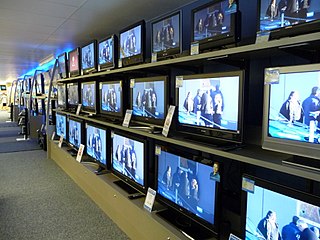
Television (TV) is a telecommunication medium for transmitting moving images and sound. Additionally, the term can refer to a physical television set rather than the medium of transmission. Television is a mass medium for advertising, entertainment, news, and sports. The medium is capable of more than "radio broadcasting," which refers to an audio signal sent to radio receivers.
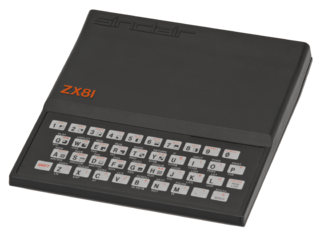
The ZX81 is a home computer that was produced by Sinclair Research and manufactured in Dundee, Scotland, by Timex Corporation. It was launched in the United Kingdom in March 1981 as the successor to Sinclair's ZX80 and designed to be a low-cost introduction to home computing for the general public. It was hugely successful; more than 1.5 million units were sold. In the United States it was initially sold as the ZX-81 under licence by Timex. Timex later produced its own versions of the ZX81: the Timex Sinclair 1000 and Timex Sinclair 1500. Unauthorized ZX81 clones were produced in several countries.

Sir Clive Marles Sinclair was an English entrepreneur and inventor, best known for being a pioneer in the computing industry and also as the founder of several companies that developed consumer electronics in the 1970s and early 1980s.
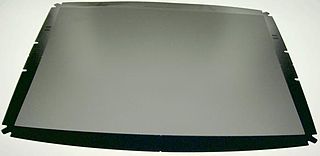
The shadow mask is one of the two technologies used in the manufacture of cathode-ray tube (CRT) televisions and computer monitors which produce clear, focused color images. The other approach is the aperture grille, better known by its trade name, Trinitron. All early color televisions and the majority of CRT computer monitors used shadow mask technology. Both of these technologies are largely obsolete, having been increasingly replaced since the 1990s by the liquid-crystal display (LCD).
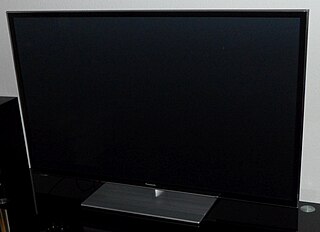
A plasma display panel is a type of flat-panel display that uses small cells containing plasma: ionized gas that responds to electric fields. Plasma televisions were the first large flat-panel displays to be released to the public.
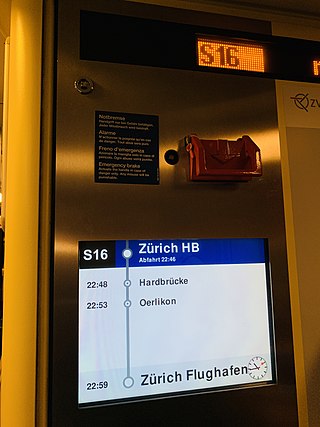
A flat-panel display (FPD) is an electronic display used to display visual content such as text or images. It is present in consumer, medical, transportation, and industrial equipment.

A television set or television receiver is an electronic device for viewing and hearing television broadcasts, or as a computer monitor. It combines a tuner, display, and loudspeakers. Introduced in the late 1920s in mechanical form, television sets became a popular consumer product after World War II in electronic form, using cathode-ray tube (CRT) technology. The addition of color to broadcast television after 1953 further increased the popularity of television sets in the 1960s, and an outdoor antenna became a common feature of suburban homes. The ubiquitous television set became the display device for the first recorded media for consumer use in the 1970s, such as Betamax, VHS; these were later succeeded by DVD. It has been used as a display device since the first generation of home computers and dedicated video game consoles in the 1980s. By the early 2010s, flat-panel television incorporating liquid-crystal display (LCD) technology, especially LED-backlit LCD technology, largely replaced CRT and other display technologies. Modern flat-panel TVs are typically capable of high-definition display and can also play content from a USB device. In the late 2010s, most flat-panel TVs began offering 4K and 8K resolutions.
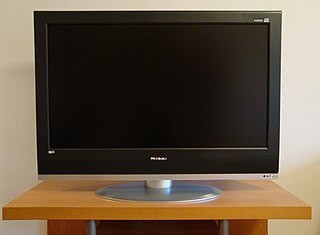
A liquid-crystal-display television is a television set that uses a liquid-crystal display to produce images. It is by far the most widely produced and sold type of television display. LCD TVs are thin and light, but have some disadvantages compared to other display types such as high power consumption, poorer contrast ratio, and inferior color gamut.

A backlight is a form of illumination used in liquid-crystal displays (LCDs) that provides illumination from the back or side of a display panel. LCDs do not produce light by themselves, so they need illumination to produce a visible image. Backlights are often used in smartphones, computer monitors, and LCD televisions. They are used in small displays to increase readability in low light conditions such as in wristwatches. Typical sources of light for backlights include light-emitting diodes (LEDs) and cold cathode fluorescent lamps (CCFLs).
Sinclair Research Ltd is a British consumer electronics company founded by Clive Sinclair in Cambridge in the 1970s. In 1980, the company entered the home computer market with the ZX80 at £99.95, at that time the cheapest personal computer for sale in the United Kingdom. A year later, the ZX81 became available through retailers, introducing home computing to a generation, with more that 1.5 million sold. In 1982 the ZX Spectrum was released, becoming the UK's best selling computer, and competing aggressively against Commodore and Amstrad.

A surface-conduction electron-emitter display (SED) is a display technology for flat panel displays developed by a number of companies. SEDs uses nanoscopic-scale electron emitters to energize colored phosphors and produce an image. In a general sense, a SED consists of a matrix of tiny cathode-ray tubes, each "tube" forming a single sub-pixel on the screen, grouped in threes to form red-green-blue (RGB) pixels. SEDs combine the advantages of CRTs, namely their high contrast ratios, wide viewing angles, and very fast response times, with the packaging advantages of LCD and other flat panel displays.

FD Trinitron/WEGA is Sony's flat version of the Trinitron picture tube. This technology was also used in computer monitors bearing the Trinitron mark. The FD Trinitron used computer-controlled feedback systems to ensure sharp focus across a flat screen. The FD Trinitron reduces the amount of glare on the screen by reflecting much less ambient light than spherical or vertically flat CRTs. Flat screens also increase total image viewing angle and have less geometric distortion in comparison to curved screens. The FD Trinitron line featured key standard improvements over prior Trinitron designs including a finer pitch aperture grille, an electron gun with a greater focal length for corner focus, and an improved deflection yoke for color convergence. Sony would go on to receive an Emmy Award from the National Academy of Television Arts and Sciences for its development of flat screen CRT technology.

Page orientation is the way in which a rectangular page is oriented for normal viewing. The two most common types of orientation are portrait and landscape. The term "portrait orientation" comes from visual art terminology and describes the dimensions used to capture a person's face and upper body in a picture; in such images, the height of the display area is greater than the width. The term "landscape orientation" also reflects visual art terminology, where pictures with more width than height are needed to fully capture the horizon within an artist's view.
A handheld television is a portable device for watching television that usually uses a TFT LCD or OLED and CRT color display. Many of these devices resemble handheld transistor radios.
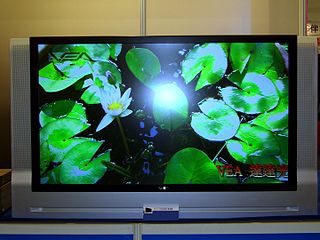
Large-screen television technology developed rapidly in the late 1990s and 2000s. Prior to the development of thin-screen technologies, rear-projection television was standard for larger displays, and jumbotron, a non-projection video display technology, was used at stadiums and concerts. Various thin-screen technologies are being developed, but only liquid crystal display (LCD), plasma display (PDP) and Digital Light Processing (DLP) have been publicly released. Recent technologies like organic light-emitting diode (OLED) as well as not-yet-released technologies like surface-conduction electron-emitter display (SED) or field-emission display (FED) are in development to supersede earlier flat-screen technologies in picture quality.
The Aiken tube was the first successful flat panel black-and-white television. Originally designed in the early 1950s, a small number of tubes were built in 1958 for military use in a collaboration with Kaiser Industries. An extended patent battle followed with a similar technology developed in the United Kingdom, and planned commercial production for the home market never started. Further development was carried out by a number of companies, including Sinclair Electronics and RCA, after the patents had expired. The displays were only produced in small quantities for military applications and oscilloscopes.




















